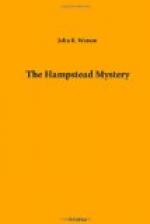Rolfe looked at his watch. It was nine o’clock. He decided to go to Hampstead and put his suspicions to the test. It was quite possible he was mistaken, but if, on the other hand, Hill was paying a nocturnal visit to Riversbrook and he had the luck to capture him, he might extract from him some valuable evidence for the forthcoming trial that Hill had kept back. And Rolfe was above all things interested at that moment in making the case for the prosecution as strong as possible.
Rolfe walked to the Camden Town Underground station, bought a ticket for Hampstead, and took his seat in the tube in that state of exhilarated excitement which comes to the detective when he feels that he is on the road to a disclosure. The speed of the train seemed all too slow for the police officer, and he looked at his watch at least a dozen times during the short journey from Camden Town to Hampstead.
When Rolfe arrived at Hampstead he set out at a rapid walk for Riversbrook. It was quite dark when he reached Tanton Gardens. He turned into the rustling avenue of chestnut trees, and strode swiftly down till he reached the deserted house of the murdered man.
The gate was locked as he had left it, but Rolfe climbed over it. A late moon was already throwing a refulgent light through the evening mists, silvering the tops of the fir trees in front of the house. Rolfe walked through the plantation, his footsteps falling noiselessly on the pine needles which strewed the path. He quickly reached the other side of the little wood, and the Italian garden lay before him, stretching in silver glory to the dark old house beyond.
Rolfe stood still at the edge of the wood, and glanced across the moonlit garden to the house. It seemed dark, deserted and desolate. There was no sign of a light in any of the windows facing the plantation.
The moon, rising above the fringe of trees in the woodland which skirted the meadows of the east side of the house, cast a sudden ray athwart the upper portion of the house. But the windows of the retreating first story still remained in shadow. Rolfe scrutinised these windows closely. There were three of them—he knew that two of them opened out from the bedroom the dead man used to occupy, and the third one belonged to the library adjoining—the room where the murder had been committed. The moonlight, gradually stealing over the house, revealed the windows of the bedroom closed and the blinds down, but the library was still in shadow, for a large chestnut-tree which grew in front of the house was directly in the line of Rolfe’s vision.




